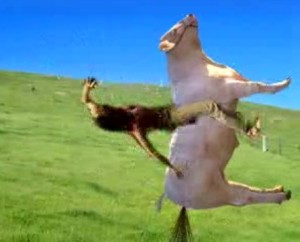Escherichia coli O26 has been identified as the most common non-O157 Shiga toxin-producing E. coli (STEC) serogroup to cause human illnesses in the United States and has been implicated in outbreaks around the world. E. coli has high genomic plasticity, which facilitates the loss or acquisition of virulence genes.
 Attaching and effacing E. coli (AEEC) O26 strains have frequently been isolated from bovine feces, and there is a need to better characterize the relatedness of these strains to defined molecular pathotypes and to describe the extent of their genetic diversity.
Attaching and effacing E. coli (AEEC) O26 strains have frequently been isolated from bovine feces, and there is a need to better characterize the relatedness of these strains to defined molecular pathotypes and to describe the extent of their genetic diversity.
High-throughput real-time PCR was used to screen 178 E. coli O26 isolates from a single U.S. cattle feedlot, collected from May to July 2011, for the presence or absence of 25 O26 serogroup-specific and virulence-associated markers. The selected markers were capable of distinguishing these strains into molecularly defined groups (yielding 18 unique marker combinations). Analysis of the clustered regularly interspaced short palindromic repeat 1 (CRISPR1) and CRISPR2a loci further discriminated isolates into 24 CRISPR types. The combination of molecular markers and CRISPR typing provided 20.8% diversity. The recent CRISPR PCR target SP_O26-E, which was previously identified only in stx2-positive O26:H11 human clinical strains, was identified in 96.4% (161/167 [95% confidence interval, 99.2 to 93.6%]) of the stx-negative AEEC O26:H11 bovine fecal strains. This supports that these stx-negative strains may have previously contained a prophage carrying stx or could acquire this prophage, thus possibly giving them the potential to become pathogenic to humans.
These results show that investigation of specific genetic markers may further elucidate our understanding of the genetic diversity of AEEC O26 strains in bovine feces.
Genetic diversity and pathogenic potential of attaching and effacing Escherichia coli O26:H11 strains recovered from bovine feces in the United States
Applied and Environmental Microbiology
Sarah A. Ison, Sabine Delannoy, Marie Bugarel, Kendra K. Nightingale, Hattie E. Webb, David G. Renter, Tiruvoor G. Nagarajac, Guy H. Loneragana and Patrick Fachb
http://aem.asm.org/content/81/11/3671.abstract?etoc
Shiga toxin-producing Escherichia coli (STEC) is a foodborne pathogen that may be responsible for severe human infections. Only a limited number of serotypes, including O26:H11, are involved in the majority of serious cases and outbreaks. The main virulence factors, Shiga toxins (Stx), are encoded by bacteriophages.
 Seventy-four STEC O26:H11 strains of various origins (including human, dairy, and cattle) were characterized for their stx subtypes and Stx phage chromosomal insertion sites. The majority of food and cattle strains possessed the stx1a subtype, while human strains carried mainly stx1a or stx2a. The wrbA and yehV genes were the main Stx phage insertion sites in STEC O26:H11, followed distantly by yecE and sbcB. Interestingly, the occurrence of Stx phages inserted in the yecE gene was low in dairy strains. In most of the 29 stx-negative E. coli O26:H11 strains also studied here, these bacterial insertion sites were vacant. Multilocus sequence typing of 20 stx-positive or stx-negative E. coli O26:H11 strains showed that they were distributed into two phylogenetic groups defined by sequence type 21 (ST21) and ST29. Finally, an EspK-carrying phage was found inserted in the ssrA gene in the majority of the STEC O26:H11 strains but in only a minority of the stx-negative E. coli O26:H11 strains.
Seventy-four STEC O26:H11 strains of various origins (including human, dairy, and cattle) were characterized for their stx subtypes and Stx phage chromosomal insertion sites. The majority of food and cattle strains possessed the stx1a subtype, while human strains carried mainly stx1a or stx2a. The wrbA and yehV genes were the main Stx phage insertion sites in STEC O26:H11, followed distantly by yecE and sbcB. Interestingly, the occurrence of Stx phages inserted in the yecE gene was low in dairy strains. In most of the 29 stx-negative E. coli O26:H11 strains also studied here, these bacterial insertion sites were vacant. Multilocus sequence typing of 20 stx-positive or stx-negative E. coli O26:H11 strains showed that they were distributed into two phylogenetic groups defined by sequence type 21 (ST21) and ST29. Finally, an EspK-carrying phage was found inserted in the ssrA gene in the majority of the STEC O26:H11 strains but in only a minority of the stx-negative E. coli O26:H11 strains.
The differences in the stx subtypes and Stx phage insertion sites observed in STEC O26:H11 according to their origin might reflect that strains circulating in cattle and foods are clonally distinct from those isolated from human patients.
Diversity of shiga toxin-producing Escherichia coli (STEC) O26:H11 strains examined via stx subtypes and insertion sites of stx and espk bacteriophages
Applied and Environmental Microbiology
Ludivine Bonanno, Estelle Loukiadis, Patricia Mariani-Kurkdjian, Eric Oswald, Lucille Garnier, Valérie Michel and Frédéric Auvray
